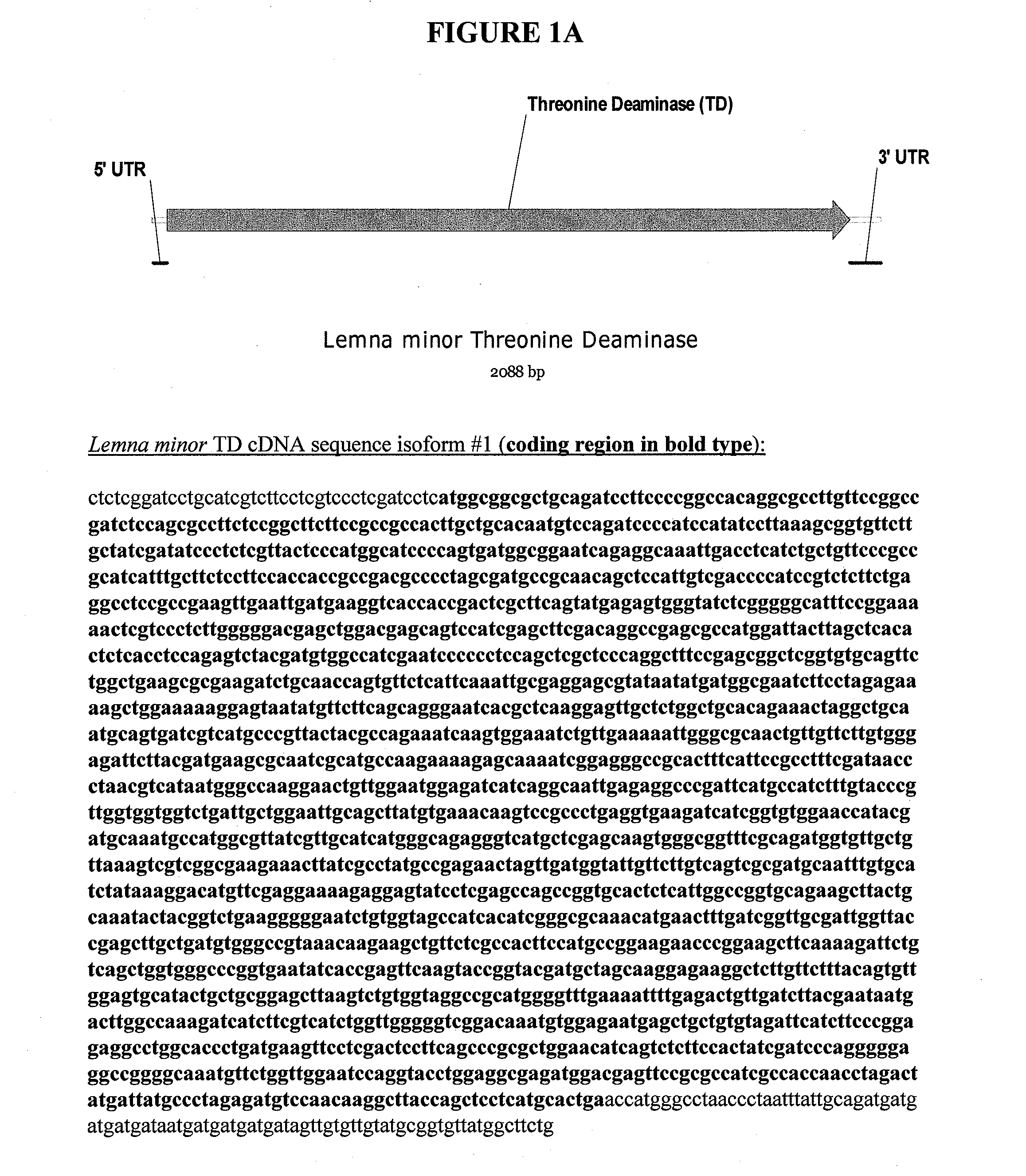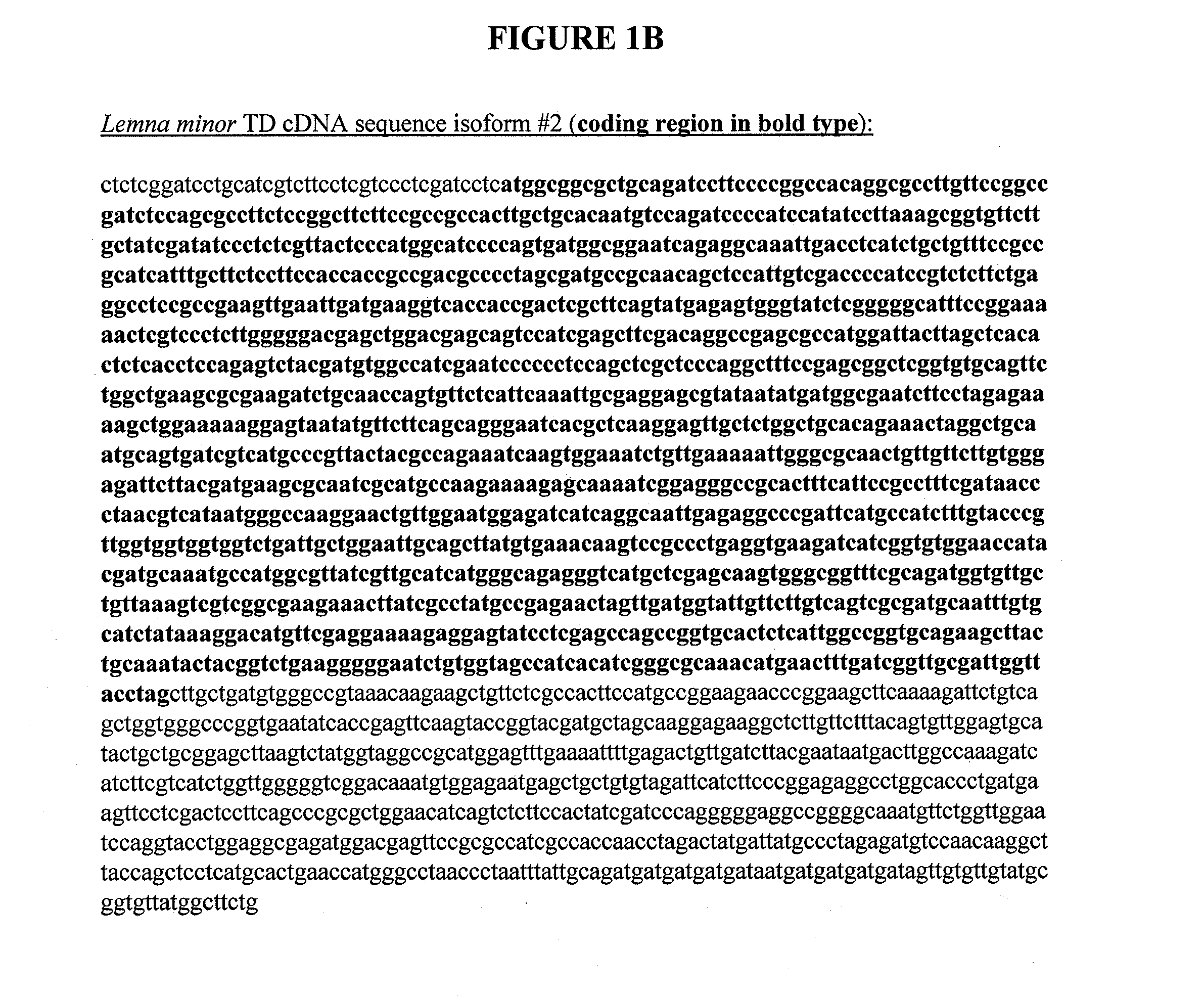Compositions and Methods for Making and Biocontaining Auxotrophic Transgenic Plants
a technology of auxotrophic plants and bio-containing substances, applied in the field of transgenic plants and plant parts, can solve problems such as significant ecological impact, and achieve the effect of reducing expression and production of said heterologous polypeptides
- Summary
- Abstract
- Description
- Claims
- Application Information
AI Technical Summary
Benefits of technology
Problems solved by technology
Method used
Image
Examples
example 1
Genetic Engineering of a Lemna Isoleucine Auxotroph
[0517]Amino acids have fundamental roles both as building blocks of proteins and as intermediates in cellular metabolism. The ability of plants to synthesize the entire group of 20 amino acids is critical to their survival and thus can serve as an avenue for auxotroph development. The biosynthesis of isoleucine in plants takes place as part of the aspartic acid metabolic pathway where isoleucine is generated through the catabolism of threonine. Threonine deaminase (TD) is responsible for the conversion of threonine to 2-ketobutyrate, a key precursor in the isoleucine biosynthesis pathway. There is also evidence of an alternative pathway in which 2-ketobutyric acid is derived from methionine in times of osmotic stress via Met γ-lyase, however threonine appears to be the predominant precursor for isoleucine biosynthesis in plants. This conclusion is based on recent data showing that a T-DNA knockout mutant of Met γ-lyase did not alter...
example 2
Genetic Engineering of Lemna Glutamine Auxotroph
[0548]An RNAi approach similar to that described in Example 1 was utilized to engineer a Lemna glutamine auxotroph. cDNAs encoding two isoforms of a cytosolic glutamine synthetase (GS1) and two isoforms of a plastid-localized glutamine synthetase (S2) were cloned from Lemna minor using degenerate primer PCR with primers designed from amino acid sequence alignments of published GS sequences from other plant species. The full-length cDNAs for L. minor GS1 isoform #1 and L. minor GS1 isoform #2 are set forth in SEQ ID NOs:7 and 10, respectively. The full-length cDNAs for L. minor GS2 isoform #1 and L. minor GS2 isoform #2 are set forth in SEQ ID NOs:13 and 16, respectively.
[0549]A chimeric RNAi construct was designed based on the cDNAs for GS1 isoform #1 (SEQ ID NO:7) and GS2 isoform #1 (SEQ ID NO:13). A schematic showing this RNAi construct is shown in FIG. 6. This chimeric RNAi construct was cloned into two different vectors to generate...
example 3
Genetic Engineering of a Lemna Biotin Auxotroph
[0559]Two approaches were used to generate Lemna biotin auxotroph lines. In the first approach, constructs overexpressing the biotin-binding protein streptavidin were utilized to essentially titrate out endogenous biotin and generate an zuxotrophic requirement for this vitamin. In the second approach, an RNAi construct similar to that described in Example 1 was utilized to knockdown expression of biotin synthase.
[0560]Stretavidin expression vectors AUXA01 (FIG. 17) and AUXA02 (FIG. 18) were designed. AUXA01 contains the Superpromoter driving expression of the mature streptavidin protein with an α-gliadin signal sequence, and AUXA02 contains the Superpromoter driving expression of a core region of streptavidin.
[0561]For RNAi suppression of biotin synthase, cDNAs encoding two isoforms of a biotin synthase were cloned from Lemna minor using degenerate primer PCR with primers designed from amino acid sequence alignments of published biotin ...
PUM
| Property | Measurement | Unit |
|---|---|---|
| Fraction | aaaaa | aaaaa |
Abstract
Description
Claims
Application Information
 Login to View More
Login to View More - R&D
- Intellectual Property
- Life Sciences
- Materials
- Tech Scout
- Unparalleled Data Quality
- Higher Quality Content
- 60% Fewer Hallucinations
Browse by: Latest US Patents, China's latest patents, Technical Efficacy Thesaurus, Application Domain, Technology Topic, Popular Technical Reports.
© 2025 PatSnap. All rights reserved.Legal|Privacy policy|Modern Slavery Act Transparency Statement|Sitemap|About US| Contact US: help@patsnap.com



